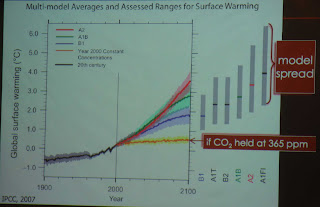
On Valentine's Day this year, I went to my workstation to discover a polite message from Microsoft that they had, without my knowledge or permission, downloaded a software update to my computer. Not only this, but they had also rebooted my computer, destroying all of the placemarks and work-in-progress that I had left up and running so that I could continue working on it the next morning. Thanks Microsoft!
This issue relates to "green" because the proper functioning of the Internet relates to "green," assuming that the Internet helps us to be "greener." (That the Internet does this has been disputed. However, my experience with the Internet as an expediter of productivity and an alternative to physical transportation indicates to me that almost any detailed calculation of electricity use by computers will be swamped out by these energy saving factors. It is sort of like comparing the green-ness of the New York City subway system to having all of those people driving cars instead. It almost does not matter how inefficient the subway is. Because of economies of scale, it will still be vastly "greener" than a system that requires people to drive in invidual vehicles.)
Microsoft has done something similar at least once before. About six months ago they had what they considered to be another security update, and I had elected not to download and install it. This update would verify [for Microsoft] that my operating system was a legitimate licensed version of the Microsoft XP operating system. Well, I already knew that, many times over. I had purchased my Hewlett-Packard computer from a legitimate store, and it came with the operating system installed. I knew Microsoft had checked it many times over the Internet, whenever I did an update from their website. I also, out of curiosity, had run their internal operating system check to verify that this was a legitimate version. Enough is enough. So I elected for a long time not to download this verification system. Then one day, the option to download it had disappeared. I doubted that it disappeared because Microsoft simply averred in its persistence.
It is time for Microsoft to reduce or drop its paranoia within the boundaries of America. Yes, I can understand their paranoia with respect to China, for the stories are many about piracy there. Such piracy simply does not make a lot of sense when most computers are sold with the Microsoft operating system already installed. I remember some years ago when Microsoft first came out with its inflated figures for how many of their operating system instances they thought had been installed or pirated. My reaction to that was to note the larger number of copies of Microsoft operating systems my businesses and I had disposed of than we were currently using. Many of them I have never registered formally with Microsoft, because it took time and offered little to me. So I figured that MS must be counting all of those unregistered operating systems, and many of those discards as pirated operating systems, even though they clearly were not. If Microsoft were not using statistics like this in a key way, then how else would they be divining the huge numbers they claimed for piracy?
Summary conclusion: Microsoft paranoia and resulting public relations is not adequate justification for their tampering with computers. I now always make a point of physically disconnecting my computers from the Internet when I am away. I am also one large step further along in dropping Microsoft in favor of Linux or Mac. It is not easy given that I am fluent in Microsoft Access and Microsoft Basic, but it will eventually happen.



